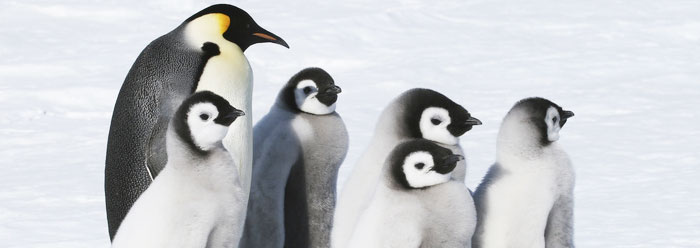Paleontologists at the University of Texas at Austin and other institutions have investigated the fossil of a giant penguin found in Peru. At five feet tall, it would have dwarfed today's largest living penguins. A UT press release stated, "The fossil shows [that] the flipper and feather shapes that make penguins such powerful swimmers evolved early."1
The sudden appearance of penguins has been an evolutionary mystery. Their fossils are rare, prompting at least one evolutionist to speculate on penguin origins based on the kinds of fleas they have in common with rodents! Writing in Vertebrate History: Problems in Evolution, technical author Barbara Stahl stated, "Since no site has yet given up a specimen recognizable as protopenguin, it is impossible to guess where or even in which climate penguin history began."2
The Peruvian penguin, named Inkayacu paracasensis, is not a protopenguin either. Instead, it has all of the standard penguin features, including a torpedo-shaped body, solid bones to decrease buoyancy, short and stiff feathers for underwater life, and flipper-like wings.
But after supposedly 36 million years,3 the wings and feathers of this fossil had original melanosomes, like other fossilized animal remains that have recently been described.4,5,6,7 These structures, manufactured by special skin cells, contain the pigment melanin. They can be used to absorb harmful sunlight, provide a camouflaged covering, or, in the case of penguins, add resilience to feathers. Melanin is long-lasting--but not this long.
The researchers compared the penguin melanosomes to those in living bird feathers and were able to reconstruct its color patterns. While they speculated on why the patterns of dark melanosomes and therefore colors might have evolved from Inkayacu's reddish brown and gray feathers to today's "black tuxedo," the curious question as to how melanosomes could possibly defy decay for millions of years went unanswered.3
According to the universal law of entropy, all large, well-organized biomolecules such as these should have fallen apart after only hundreds of thousands of years. Scientists observe that all systems tend toward decay unless otherwise acted upon by an energy-using, information-giving maintenance system. So, with no maintenance systems, how did these melanosomes inside the penguin feathers resist decay for 36 million years?
The most straightforward answer is that the date that has been provided for this fossil and its attendant rock layer is totally wrong, and that they were both formed much more recently. Thousands, not millions, of years fit both these facts of science and Scripture-based earth history.
References
- Fossilized Giant Penguin Reveals Unusual Colors, Sheds Light on Bird Evolution. The University of Texas at Austin press release, September 30, 2010.
- Stahl. B. J. 1985. Vertebrate History: Problems in Evolution. New York: Dover Publications, 385.
- Clarke, J. et al. Fossil Evidence for Evolution of the Shape and Color of Penguin Feathers. Science Express. Published online before print September 30, 2010.
- Thomas, B. Fossil Feathers Convey Color. ICR News. Posted on icr.org July 21, 2008, accessed October 11, 2010.
- Thomas, B. Fresh Fossil Feather Nanostructures. ICR News. Posted on icr.org September 16, 2009, accessed October 11, 2010.
- Thomas, B. Feathered Dinosaur Debate Exhibits Young Earth Evidence. ICR News. Posted on icr.org February 8, 2010, accessed October 11, 2010.
- Thomas, B. '80 Million-Year-Old' Mosasaur Fossil Has Soft Retina and Blood Residue. ICR News. Posted on icr.org August 20, 2010, accessed October 11, 2010.
* Mr. Thomas is Science Writer at the Institute for Creation Research.
Article posted on October 19, 2010.




